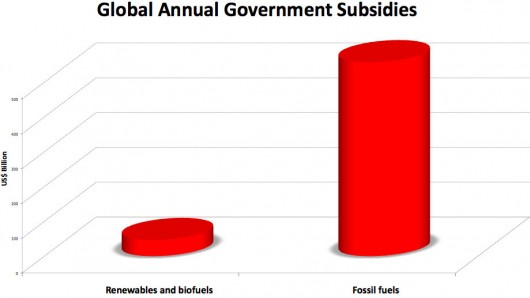New research shows real government subsidies for clean and dirty power
21:55 August 1, 2010

How can you tell when a politician is lying? First check to see if his/her lips are moving. New research has revealed that despite what they would have you believe, the world’s governments subsidize the fossil fuel sector far more than they do renewables and biofuels. Indeed, the assistance delivered to the oil, coal, and other fossil fuel sectors makes a mockery of claims that government is serious about reducing carbon emissions. Hey folks, that’s YOUR MONEY!
New Energy Finance Limited was acquired by Bloomberg in December 2009, and its services and products are now distributed by Bloomberg Finance as Bloomberg New Energy Finance (BNEF).
BNEF provides news, data, research and analysis to decision-makers in renewable energy, energy smart technologies, carbon markets, carbon capture and storage, and nuclear power. Bloomberg New Energy Finance Insight Services provide deep market analysis to investors in wind, solar, bioenergy, geothermal, carbon capture and storage, energy efficiency, and nuclear power.
The following BNEF press release was issued July 30, 2010.
New research from Bloomberg New Energy Finance reveals that despite many platitudes and pledges, governments of the world are spending substantially more on subsidizing dirty forms of energy than on renewables and biofuels. In fact, support for cleaner sources is dwarfed by the help the oil, coal, and other fossil fuel sectors receive.
In all, governments of the world provided approximately $43-46bn to renewable energy and biofuels technologies, projects, and companies in 2009, BNEF concludes in preliminary analysis. This total includes the cost of feed-in-tariffs (FiTs), renewable energy credits or certificates (RECs), tax credits, cash grants, and other direct subsidies. (It does not include more upstream support, such as subsidies to corn farmers to grow feedstock for use in US ethanol plants, nor does not include any value transfer due to carbon cap-and-trade schemes.)
The $43-46bn figure stands in stark contrast to the $557bn spent on subsidizing fossil fuels in 2008, as estimated by the International Energy Agency last month.
"One of the reasons the clean energy sector is starved of funding is because mainstream investors worry that renewable energy only works with direct government support," said Michael Liebreich, chief executive of Bloomberg New Energy Finance. "Setting aside the fact that in many cases clean energy competes on its own merits - for instance in the case of well-situated wind farms and Brazilian sugar-cane ethanol - this analysis shows that the global direct subsidy for fossil fuels is around ten times the subsidy for renewables. And that is without taking into account the enormous security and public health costs of fossil fuels, as well as the appalling pollution catastrophes on the Gulf Coast, the Niger Delta and elsewhere." The BNEF preliminary analysis suggests the US is the top country, as measured in dollars deployed, in providing direct subsidies for clean energy with an estimated $18.2bn spent in total in 2009. Approximately 40% of this went toward supporting the US biofuels sector with the rest going towards renewables. The federal stimulus program played a key role; its Treasury Department grant program alone provided $3.8bn in support for clean energy projects.
China, the world leader in new wind installations in 2009 with 14GW, provided approximately $2bn in direct subsidies, according to the preliminary analysis. This figure is deceptive, however, as much crucial support for clean energy in the country comes in form of low-interest loans from state-owned banks. State-run power generators and grid companies have also been strongly encouraged by the government to tap their balance sheets in support of renewables.
Feed-in-tariffs (FiT) subsidizing the purchase of clean electricity in Europe accounted for roughly $19.5bn of the total 2009 spend, or just under half the global total. Germany is home to what was the world’s single most expensive clean energy subsidy program in 2009, BNEF's preliminary research found. Its FiT cost Germany’s ratepayers an estimated $9.6bn in 2009 and is a reflection of the extraordinary number of PV systems installed in the country in recent years.
The gap between what governments spend on subsidizing fossil fuels and clean energy should narrow considerably in 2010 for two reasons. First, support for renewables and biofuels will grow as disbursement of $188bn in global stimulus funds for clean energy accelerates, based on BNEF research. Second, the amount governments such as China spend to keep fossil fuel prices artificially low for consumers has dropped as oil prices retreated from their mid-2008 peaks. Simply put, less government support is needed to make these dirty sources of energy more affordable to populations around the globe.
Copyright © gizmag 2003 - 2010 To subscribe or visit go to: http://www.gizmag.com